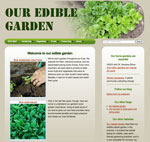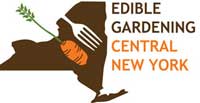Seeds for Education
|  |
Wild Ones provides grants for schools, and they've received 40 applications for 2013. Please let the SFE national director know if you'd be interested in being a judge to determine which applications are granted. And donate to this worthwhile program if you are able so that more projects can be funded. More info...
|
Project BudBurst's 2nd annual
Fall into Phenology | |
| |
Share your fall observations of plants changing color, shedding leaves, and more. Read more at budburst.org/fall
You can submit data for this campaign until Oct. 31.
|
Pioneer Adventures Day Camp at Baltimore Woods
Mon. Nov 12, 9-4
Ages 5-12
|

| | Ebony spleenwort |
| |
Come to camp for a fun filled day when we'll use games and activities to rediscover pioneer living.
Camp is available only to our current family members, and costs only $40 per camper.
Space is limited - don't miss out!
Phone: 315 673-1350
|
| Our Habitat Garden |  |
Visit Our Habitat Garden website for information on providing habitat, earth-friendly gardening practices, plants, and various creatures here in Central New York.
|
| HGCNY on Facebook |
As as more of us participate on our Facebook page, this will become a useful resource for asking (and answering!) local HGCNYers' questions about habitat gardening. |
|
Join HGCNY!
|  |
Becoming an official member of HGCNY is easy: just join Wild Ones! When you're a Wild Ones member, you're automatically an official member of HGCNY. |
|
Our Edible Garden
|  | Visit OurEdibleGarden.org to see an example of a Central New York edible garden, the perfect companion to your habitat garden.
|
| Interested in Edible Gardening? | 
|
If you'd like to get information on Edible Gardening CNY, just email John to find out about edible gardening tours and monthly programs. Free and open to the public! |
|
Greetings!
 | | Never too early to start! |
For our October meeting, we're pleased to bring back one of our most popular presenters, Andrew Saunders, retired SUNY-ESF professor. In the past, he's talked with us about the fascinating black walnut tree (and even brought along a delicious black walnut pie!), and he showed us how to keep nature journals. This time he'll present tips on nature photography. Come learn from an expert nature observer. This program is suitable for any level of photographer. When: Sunday Oct. 28 at 2:00 pm Where: Liverpool Library ( Directions) Free and open to the publicSpeaking of photographs...
Wild Ones members can login to the Wild Ones website and vote for the People's Choice photograph in the annual photo contest! Mark your calendars for the last Sunday of the month for a year of terrific programs! They're free and open to the public.
 | | BEE involved! |
It's Election Time!No, not that one -- our HGCNY election! If you'd like to be on our Board and/or hold an office, please let me know. We're especially looking for a Secretary to take minutes at our Board meetings. We meet three times a year, generally in June/July, Sept./Oct and March/April. We also communicate by email for issues that come up between these times.
We have enjoyable, cordial meetings, and we'd love to have more WO members involved in planning our activities and programs!
Janet Allen
President, HGCNY
|
|
|
Dead wood brings new life
 | A snag -- the wildlife tree
|
From the Washington State Dept of Fish & Wildlife:
Birds, small mammals, and other wildlife use snags for nests, nurseries, storage areas, foraging, roosting, and perching. Live trees with snag-like features, such as hollow trunks, excavated cavities, and dead branches can provide similar wildlife value... Dead branches are often used as perches; snags that lack limbs are often more decayed and, may have more and larger cavities for shelter and nesting. Snags enhance local natural areas by attracting wildlife species that may not otherwise be found there. All trees of all sizes are potential snags. Unfortunately, many wildlife trees are cut down without much thought to their wildlife value or of the potential management options that can safely prolong the existence of the tree. Wildlife trees offer a one-stop, natural habitat feature. In short, snags "live on" as excellent wildlife trees for all to enjoy! This excellent Washington Dept of Fish & Wildlife website offers many additional practical suggestions about snags, including how to create a snag (a good use for a Norway maple) and how to create a cavity in a living tree! |
|
Robins on the move
 | | Robin in winterberry |
We always look forward to seeing our first robin as a sign of spring. But some (generally males) never leave!
Journey North's month-by-month description of robins' movements explains that October is the month of heaviest migration. The robins that stick around--if they survive the winter--will have first pick of the best nesting sites in spring.
In the fall, robins switch their diet from earthworms to fruits. So what will help robins survive--whether they're on the move, staying through the winter, or returning in spring? Native shrubs with the nutritious berries the birds evolved with!
Some of the native shrubs that produce berries for robins and other birds are spicebush (Lindera benzoin), Northern bayberry (Myrica pensylvanica), winterberry (Ilex verticillata), inkberry (Ilex glabra), American cranberry bush (Viburnum triloba), and chokeberry (Aronia arbutifolia).
Native shrubs with their nutritious berries are crucial for food as well as for nesting, yet they're what is missing in most urban and suburban landscapes. It's not too late to plant some more native shrubs!
Read more from Journey North about robins in winter.
Journey North, which provides abundant materials for teachers and students, has a lot of fascinating information and beautiful photographs for everyone about wildlife migration all over the world. |
 | |
Milkweed beetles eating their favorite food: milkweed seeds
|
Collect milkweed seeds!
The Wild Ones Wild for Monarchs campaign is collecting milkweed seeds in large-scale milkweed restoration projects.
Here's how you can participate:
Steps for collecting:
* Please obtain permission to collect milkweed. * Do not over-collect in one area. Pick less than 50% at each site. Safety Note: Take care, milkweed sap can harm eyes. Do not collect near busy highways. Easy Collection Steps: 1.Collect clean mature pods (as they begin to split) from native wild plants only. * Note: Don't collect pods that have numerous milkweed beetles on them--they're eating the milkweed seeds. Also, make sure no beetles get into your seed bag, giving them an easy, gourmet meal! (See photo above) * Paper bags work well. Don't use plastic. * Please dry the pods. * If you want to, clean the fluff off the seeds, and pull or shake seeds off. 2. For each location, make a new labeled bag. 3. Each species needs its own bag. 4. Label each bag with this information: * Type of milkweed (Common/Swamp/Butterflyweed)
* Your name/address/email
* Collection Date and Location (Zip/County/State)
* Size of milkweed population (small/medium/large) * Soil type (sand/clay/other)
* Ecoregion or plant community if known
* Comments
What to do with them:
We can save a portion of these wild-collected seeds for our own milkweed propagation and send a portion to Monarch Watch for large-scale restoration projects.
You can send them directly to Monarch Watch yourself or bring them to the October meeting and we'll send them. Be sure they're labeled with the required information.
For more information...
|
|
How to decipher those coffee labels
 | | Common yellowthroat |
We know that many of the birds we enjoy throughout spring, summer, and fall spend the winter in Central America. Even the tiny hummingbird makes that long journey!
But what will they find when they arrive? The coffee we choose can make a difference. Birds find good habitat in shade coffee plantations, but industrial agriculture's sun plantations don't provide the habitat they need. These shade plantations will disappear if we don't keep them economically viable. But how do you know what coffee is which and how do you avoid greenwashing?
Unfortunately, just because a label says it's "Shade-Grown" doesn't mean it provides adequate habitat.
This article from the Cornell Lab of Ornithology explains all the different labels to help you choose coffee that supports the winter habitat of the birds we enjoy in summer.
Bottom line: Coffee certified as "Bird-Friendly" by the Smithsonian Migratory Bird Center supports bird habitat. Birds & Beans coffee is one brand that carries that certification. Ask the stores you frequent to carry certified Bird-Friendly coffee and buy it! Let me know where you find it being sold locally and I'll put the information here.
|
|
|
|
|